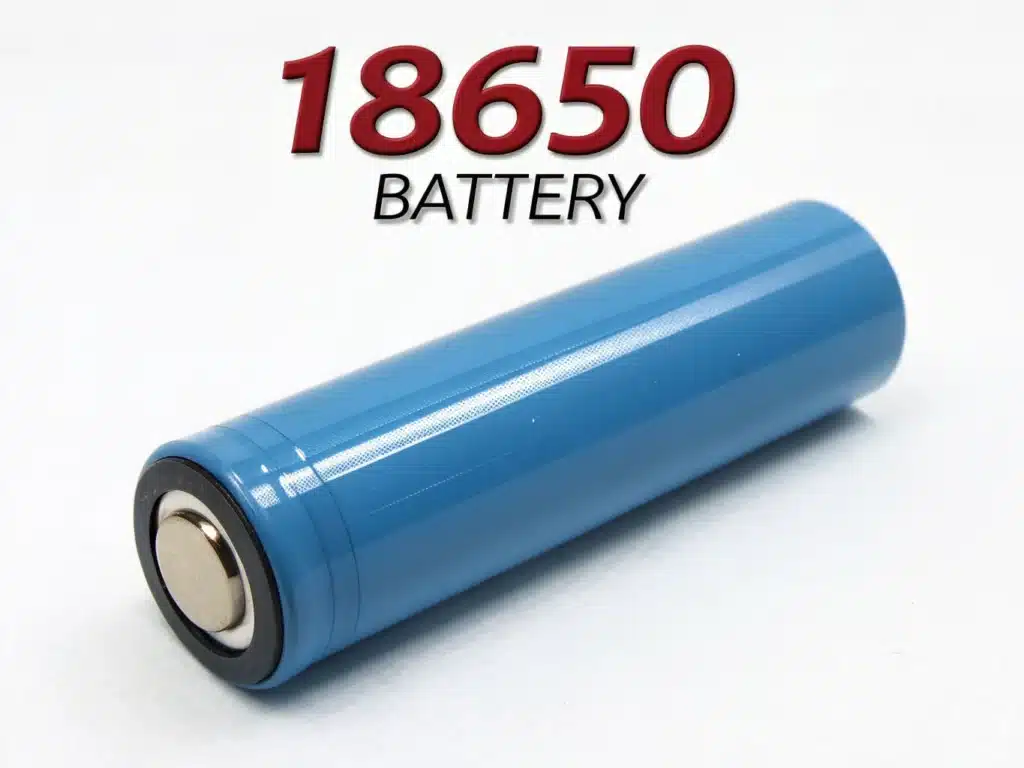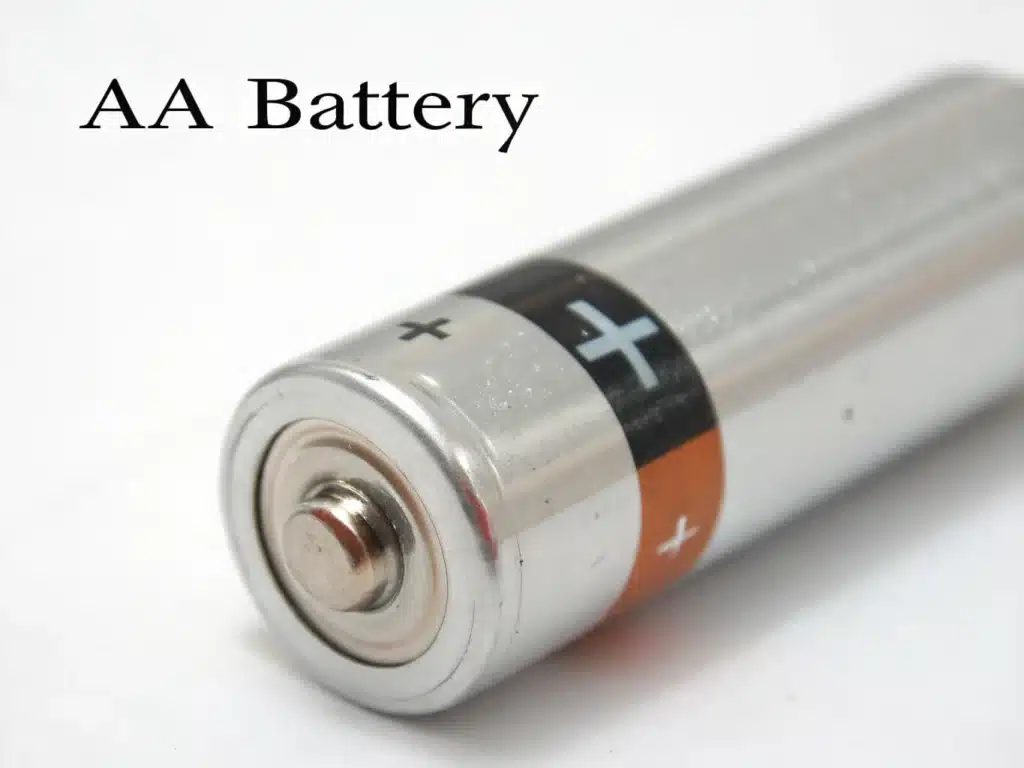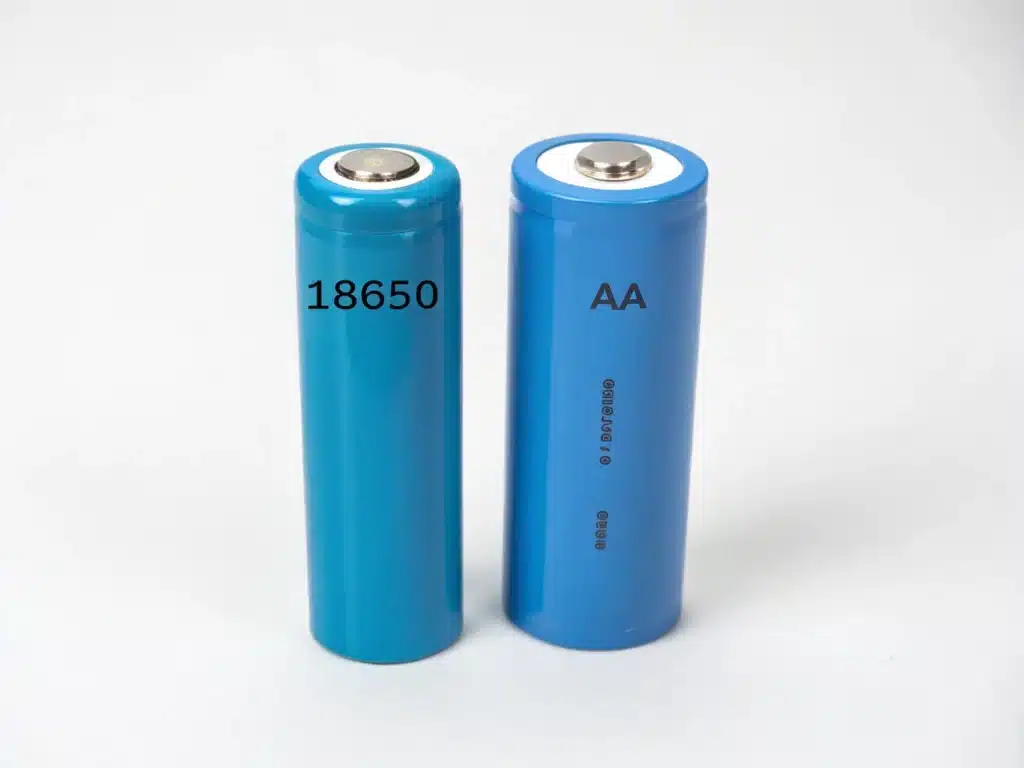Both 18650 lithium battery and AA battery (No. 5 battery) are cylindrical. However, under this similar appearance, they have huge differences in dimensions, voltage, capacity, energy density and application scenarios. This article will provide you with a clear and comprehensive comparative analysis, deeply analyzing the advantages and disadvantages of 18650 and AA batteries in various key indicators, so as to choose the best battery type for your device.
Table of Contents
ToggleWhat is 18650 battery

18650 battery is a cylindrical rechargeable lithium-ion battery with a diameter of 18 mm and a length of 65 mm. Its nominal voltage is 3.7V, the main capacity range is 2000mAh to 3500mAh, with a higher energy density and a cycle life of 500 times.
What is AA battery

AA batteries, also called No. 5 batteries, LR6 or R6, represent a standardized size shell. The most common types of AA batteries are alkaline batteries, nickel metal hydride batteries, and lithium iron batteries. Their nominal voltage is 1.5V or 1.2V, and their capacity varies according to their chemical composition to meet a wide range of needs from low power consumption to medium power consumption, and from disposable to rechargeable.
18650 battery vs AA battery comparison
Now we compare 18650 li-ion battery and AA battery from different angles, so you can quickly know their key differences.

Size and weight. 18650 batteries are longer and heavier than AA batteries.
In terms of chemical composition. 18650 is mainly lithium ion (Li-ion); while AA batteries come in many varieties, such as alkaline, nickel metal hydride (NiMH), lithium iron (Li-FeS2), etc.
Voltage. 18650 nominal voltage is 3.6V/3.7V, while AA battery is 1.5V (disposable) or 1.2V (rechargeable).
Capacity. the capacity of a single 18650 is usually much higher than a single AA battery. 18650 battery capacities are 1200mAh, 1500mAh, 1800mAh, 2000mAh, 2200mAh, 2500mAh, 2600mAh, 2800mAh, 3000mAh, 3200mAh, 3500mAh vs AA batteries, there are two main types. (Alkaline batteries are about 1800-2600mAh, NiMH batteries are 1800-2700mAh).
Energy. Energy (Wh) = Voltage (V) × Capacity (Ah). From the above voltage and capacity comparison, we can find that the energy of 18650 battery is greater than that of AA battery.
Energy density. 18650 lithium-ion battery has higher energy density. At the same weight or volume, 18650 can store more energy, which is why it is suitable for portable high-performance devices.
Discharge rate. 18650 batteries have a higher discharge rate. 18650 batteries can instantly provide a larger current, enough to drive high-power loads such as motors and e-cigarettes, while AA batteries are usually weaker in this regard.
Rechargeability. 18650 is rechargeable; AA batteries are available in different cases (NiMH rechargeable, alkaline/LiFe disposable)
Cycle life. 18650 batteries generally have 300 to 1000+ charge and discharge cycles, and AA NiMH batteries generally have 300 to 800+ charge and discharge cycles.
Cost. In the short term, the cost of 18650 batteries is significantly higher than that of single AA batteries (especially disposable AA batteries), and you also need to buy a dedicated charger for 18650 batteries. For frequent use scenarios, rechargeable 18650 batteries or NiMH AA batteries are more cost-effective in the long run than constantly buying disposable AA batteries.
Convenience. AA batteries are extremely easy to buy and can be found almost everywhere; however, 18650 batteries require professional lithium battery engineering.
Safety. 18650 batteries, if abused, damaged or of poor quality, have the risk of thermal runaway (fire, explosion). Therefore, we need to configure a protection board for it. The potential risk of AA batteries is that alkaline batteries leak, which may damage the device. Although the risk is not as severe as that of lithium-ion batteries, it is also worth noting. NiMH batteries are relatively safe.
| Feature | 18650 Battery | AA Battery | Notes |
| Size (Typical) | Ø18mm x 65mm | Ø14.5mm x 50.5mm | 18650 is significantly larger and longer. |
| Weight (Typical) | 45-50g | 20-30g (varies by type) | 18650 is considerably heavier. |
| Chemistry | Lithium-ion (Li-ion) | Various: Alkaline, NiMH, Li-FeS2… | 18650: Primarily one chemistry; AA: Diverse chemistries. |
| Nominal Voltage | 3.6V / 3.7V | 1.5V (Alkaline, Li-FeS2) / 1.2V (NiMH) | Crucial difference! Voltage incompatibility prevents direct interchangeability. |
| Capacity (Typical) | 2000 – 3500+ mAh | 1800 – 2700 mAh (depends heavily on type) | Single 18650 cell usually has higher mAh capacity than a single AA. |
| Energy (Typical) | ~7.4 – 13 Wh | ~2 – 3.8 Wh (depends on type & voltage) | Significant total energy difference! Wh (Watt-hour = V x Ah) is a fairer metric. |
| Energy Density | Generally Higher | Generally Lower (Li-FeS2 AA is an exception) | 18650 stores more energy per unit volume/weight. |
| Power Output | Generally Higher | Generally Lower | 18650 can deliver higher currents (Amps) for power-hungry devices. |
| Rechargeability | Yes (Designed to be) | Depends (NiMH: Yes; Alkaline/Li-FeS2: No) | 18650 is inherently rechargeable; AA has both single-use and rechargeable types. |
| Cycle Life (Rech.) | 300 – 1000+ cycles (Li-ion) | 300 – 800+ cycles (NiMH) | Lifespan for rechargeable types varies by quality and usage. |
| Initial Cost | Higher (Cell + dedicated charger) | Low (Single-use) / Medium (NiMH + charger) | Higher upfront investment needed for 18650 system. |
| Long-term Cost | Lower (Rechargeable) | High (Buying single-use) / Lower (NiMH) | Rechargeable options are more economical for frequent use. |
| Availability | Lower (Specialized retailers/online) | Very High (Available almost everywhere) | AA batteries are far more convenient to find and purchase. |
| Safety | Risk of thermal runaway (needs care & protection circuits) | Main risk is leakage (Alkaline) | Both have safety concerns; Li-ion requires more caution due to higher energy. |
Typical application scenarios
After understanding the differences in technical specifications between 18650 and AA batteries, you can confirm their actual application areas.
With its excellent performance parameters, 18650 batteries have become the first choice for many high-energy-consuming and high-performance portable devices, such as notebooks, power tools, robots, e-cigarettes, high-lumen flashlights, battery pack modules, and DIY projects.
AA batteries, with their standardization and convenience, mainly serve low-power or low-cost devices, such as remote controls, alarm clocks, children’s toys, ordinary LED flashlights, wireless mice and keyboards.
Which battery should I choose for my device
When you need to choose and purchase a battery, please be sure to keep in mind the following key considerations, which are directly related to the normal operation of the equipment and your personal safety.
The first rule of choosing a battery is always to follow the design specifications of your device. This requires that the voltage and power match the device requirements, and the battery’s physical size fits the device’s battery compartment space.
Safety first, especially for high-energy 18650 batteries. Try to buy high-quality 18650 batteries from reputable and well-reputed brands, such as Hongyitai lithium battery factory. Pay attention to the protection circuit (PCM/BMS) to effectively prevent dangers such as overcharge, over-discharge, short circuit and overcurrent. Avoid physical damage during use.
Matching charging equipment. 18650 batteries require a lithium-ion (Li-ion) battery charger designed specifically for them, and rechargeable AA NiMH batteries require a NiMH battery charger. Disposable AA batteries cannot be recharged.
Summary
If you need to drive high-performance, high-power devices, pursue long battery life and strong energy output, then 18650 batteries are the first choice. If you value convenience, wide compatibility, low cost, and meet the needs of low-power devices, then AA batteries are the best choice.
FAQ
Absolutely not. Due to the fundamental, irreconcilable differences in voltage (huge difference, about 3.7V vs. 1.5V/1.2V) and physical size (18650 is much larger) between 18650 and AA batteries, they are not directly interchangeable at all without risk to safety.
